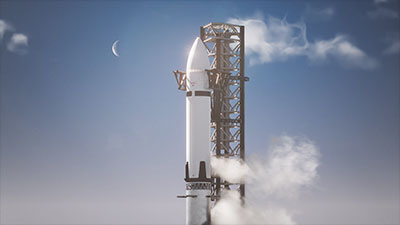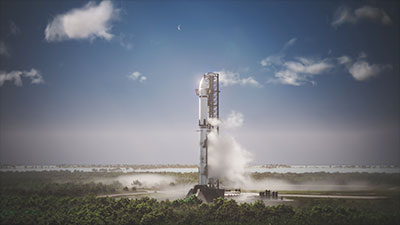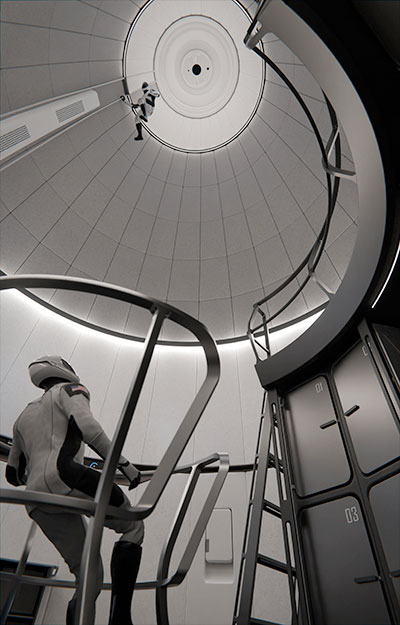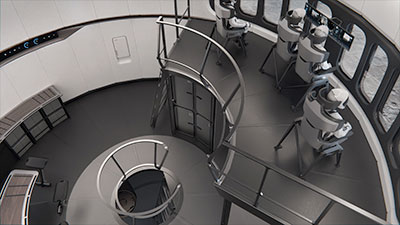To the Moon and BeyondHumanity is at an inflection point. For the first time in our existence, we possess the means, technology, and, for the moment, the will to establish a permanent human presence beyond Earth. Starship is designed to make this future a reality and is singularly capable of carrying unparalleled numbers of explorers and the building blocks they'll need to establish the first outposts on lunar and other planetary surfaces. For these reasons and more, it was chosen to fulfill the key role of landing the first astronauts on the Moon in more than 50 years. It will be a central enabler that will fulfill the vision of NASA's Artemis program, which seeks to establish a lasting presence on the lunar surface, not just flags and footprints, and ultimately forge the path to land the first humans on Mars.

Prepare For Landing
With the scale of Starship and the technological breakthroughs it is engineered to achieve, SpaceX is moving at a historically rapid pace. Starship provides unmatched capability to explore the Moon, thanks to its large size and ability to refill propellant in space. One single Starship has a pressurized habitable volume of more than 600 cubic meters, which is roughly two-thirds the pressurized volume of the entire International Space Station, and is complete with a cabin that can be scaled for large numbers of explorers and dual airlocks for surface exploration. For comparison: each of Starship's two airlocks has a habitable volume of approximately 13 cubic meters, which is more than double the space that was available in the Apollo lander. Cargo variants of the Starship lander will be capable of landing up to 100 metric tons directly on the surface, including large payloads like unpressurized rovers, pressurized rovers, nuclear reactors, and lunar habitats.
To return Americans to the Moon, SpaceX aligned Starship development along two paths: development of the core Starship system and supporting infrastructure, including production facilities, test facilities, and launch sites which SpaceX is self-funding representing over 90% of system costs and development of the HLS-specific Starship configuration, which leverages and modifies the core vehicle capability to support NASA's requirements for landing crew on and returning them from the Moon. SpaceX is working under a fixed-price contract with NASA, ensuring that the company is only paid after the successful completion of progress milestones, and American taxpayers are not on the hook for increased SpaceX costs. SpaceX provides significant insight to NASA at every stage of the development process along both paths, including access to flight data from missions not funded under the HLS contract.
Both pathways are necessary and made possible by SpaceX's substantial self-investments to enable the high-rate production, launch, and test of Starship for missions to the Moon and other purposes. Starship will bring the United States back to the Moon before any other nation and it will enable sustainable lunar operations by being fully and rapidly reusable, cost-effective, and capable of high frequency lunar missions with more than 100 tons of cargo capacity.
Path 1: Core Starship System

Since Starship Flight 1 in April 2023, SpaceX has rapidly advanced vehicle development through an active flight test campaign. In line with past vehicle development, SpaceX maximizes real-world testing throughout this process to quickly and safely demonstrate capabilities, identify areas for improvement, and prove out solutions. This campaign has quickly matured the core Starship and has produced numerous feats, including multiple successful ascents of the world's most powerful rocket; the launch, return, catch, and reuse of that rocket to unlock the high launch rate cadence needed for lunar missions; the transfer of approximately five metric tons of cryogenic propellant between tanks while in space, a first of its kind operation that provides key data for future full-scale propellant transfer operations; successful in-space relights of the Raptor engines that are critical for the maneuvers that will send Starship to the Moon; and multiple controlled reentries through Earth's atmosphere.
To date, SpaceX has produced more than three dozen Starships and 600 Raptor rocket engines, with more than 226,000 seconds of run time on the Raptor 2 engine and more than 40,000 seconds of run time on the next-generation Raptor 3 engine. There have been 11 Starship-only flight tests and 11 integrated flight tests of Starship and Super Heavy. In parallel, SpaceX has constructed, and continues to construct, new Starship launch, production, integration, and test facilities in Texas, Florida, and California. This private investment of billions of dollars is creating more than five million square feet of manufacturing and integration space, five launch pads across Texas and Florida, and multiple Raptor test stands, all engineered to ramp Starship's launch cadence above and beyond the paradigm-redefining rate achieved by SpaceX's Falcon program.
Path 2: The Lander

In parallel to development of the core Starship vehicle, SpaceX's HLS team has completed 49 milestones tied to developing the subsystems, infrastructure, and operations needed to land astronauts on the Moon. SpaceX has received money only on contractual milestones that have been successfully completed, the vast majority of which have been achieved on time or ahead of schedule. Highlights of completed milestones include:
- Lunar environmental control and life support and thermal control system demonstrations, using a full-scale cabin module inhabited by multiple people to test the capability to inject oxygen and nitrogen into the cabin environment and accurately manage air distribution and sanitation, along with humidity and thermal control. The test series also measured the acoustic environments inside the cabin
- Docking adapter qualification of the docking system that will link Starship and Orion in space, an androgynous SpaceX docking system capable of serving as the active system or passive system and based on the flight-proven Dragon 2 active docking system
- Landing leg drop test of a full-scale article at flight energies onto simulated lunar regolith to verify system performance and to study foot-to-regolith interaction
- Raptor lunar landing throttle test demonstrating a representative thrust profile that would allow Starship to land on the lunar surface
- Micrometeoroid and orbital debris testing of shielding, insulation, and window panels, analyzing different material stackups that will be used to protect Starship from impact hazards and harsh thermal conditions
- Landing software, sensor, and radar demonstrations testing navigation and sensing hardware and software that will be used by Starship to locate and safely descend to a precise landing site on the Moon
- Software architecture review to define the schematic of major vehicle control processes, what physical computers they will run on, and software functions for critical systems like fault detection, caution and warning alerts, and command and telemetry control
- Raptor cold start demonstrations using both sea-level and vacuum-optimized Raptor engines that are pre-chilled prior to startup to simulate the thermal conditions experienced after an extended time in space
- Integrated lunar mission operations plan review, covering how SpaceX and NASA will conduct integrated operations, develop flight rules and crew procedures, and the high-level mission operation plan
- Depot power module demonstration, testing prototype electrical power generation and distribution systems planned to be used on the propellant depot variant of Starship
- Ground segment and radio frequency (RF) communications demonstration, testing the capability to send and receive RF communications between a flight-equivalent ground station and a flight-equivalent vehicle RF system
- Elevator and airlock demonstration, which was conducted in concert with Axiom to utilize flight-representative pressurized EVA suits, to practice full operation of the crew elevator which will be used to transfer crew and cargo between Starship and the lunar surface
- Medical system demonstration covering the crew medical system on Starship and the telemedicine capability between the ground and crew
- Hardware in the loop testbed activation for the propellant transfer flight test which uses a testbed with flight representative hardware to run simulations for the upcoming propellant transfer flight test
Next Steps
While many of SpaceX's remaining HLS contract milestones are tied to flight tests, such as a ship-to-ship propellant transfer demonstration, SpaceX has started fabricating a flight-article Starship HLS cabin that will include functional avionics and power systems, crew systems and mechanisms, environmental control and life support systems, cabin and crew communications systems, and a cabin thermal control system. This flight-capable cabin will enable engineers to demonstrate high design maturity of the various systems required to support a human landing on the Moon, enable integrated system-level hardware testing, and provide a highly realistic training experience for future lunar explorers. The next major flight milestones tied specifically to HLS will be a long-duration flight test and the in-space propellant transfer flight test. The exact timing will be driven by how upcoming flight tests debuting the new Starship V3 architecture progress, but both of these tests are targeted to take place in 2026. On-orbit refilling enables Starship to complete the Artemis lunar mission architecture and carry up to 100 tons directly to the lunar surface, providing the capability to carry rovers, habitats, and other payloads needed to establish a permanent, and sustainable, presence on the Moon.
It will start with a Starship launched from Starbase to spend an extended time on orbit, gathering data on vehicle propulsion and thermal behavior on an extended duration mission, including long duration propellant storage and boil-off characterization. A second Starship will then launch to rendezvous with the first to demonstrate ship-to-ship propellant transfer in Earth orbit.
Starship V3 vehicles come equipped with docking ports and can be configured to act as tanker vehicles with the addition of docking probes. Starship also has a connection point where propellants are loaded onto the vehicle in preparation for launch that has been updated to enable on-orbit propellant transfer. For rendezvous, Starships will be equipped with DragonEye navigation sensors, which have extensive flight heritage from their use on SpaceX's Dragon spacecraft during dozens of dockings to the International Space Station. These sensors have undergone separate testing to characterize their performance for use on Starship. SpaceX has also been flying experimental propellant gauging sensors on every recent Starship flight test which use radio frequency measurements to accurately measure propellant levels while in microgravity.
A Permanent Return
NASA selected Starship in 2021 to serve as the lander for the Artemis III mission and return humans to the Moon for the first time since Apollo. That selection was made through fair and open competition which determined that SpaceX's bid utilizing Starship had the highest technical and management ratings while being the lowest cost by a wide margin. This was followed by a second selection to serve as the lander for Artemis IV, moving beyond initial demonstrations to lay the groundwork that will ensure that humanity's return to the Moon is permanent.
Starship continues to simultaneously be the fastest path to returning humans to the surface of the Moon and a core enabler of the Artemis program's goal to establish a permanent, sustainable presence on the lunar surface. SpaceX shares the goal of returning to the Moon as expeditiously as possible, approaching the mission with the same alacrity and commitment that returned human spaceflight capability to America under NASA's Commercial Crew program.
Since the contract was awarded, we have been consistently responsive to NASA as requirements for Artemis III have changed and have shared ideas on how to simplify the mission to align with national priorities. In response to the latest calls, we've shared and are formally assessing a simplified mission architecture and concept of operations that we believe will result in a faster return to the Moon while simultaneously improving crew safety.
NASA's Artemis program was born out of a visionary goal: to truly explore the Moon and place the first footprints on Mars. Not to repeat the accomplishments of Apollo — not to be another entry in the long list of short-lived exploration initiatives — but to be the opportunity to finally build a sustainable presence on another planet. SpaceX was founded to make life multiplanetary, and Starship has been designed from the very beginning to enable the exploration of other worlds. With it, and alongside NASA, we look forward to inspiring all of humanity as that first permanent foothold is placed among the stars.

















